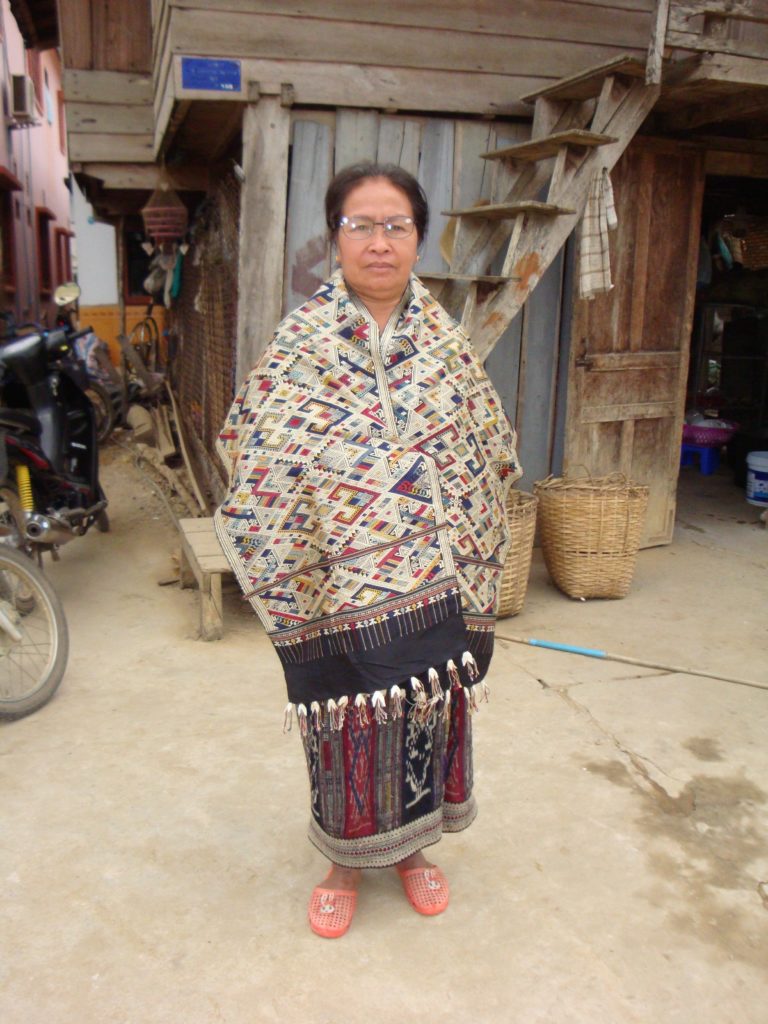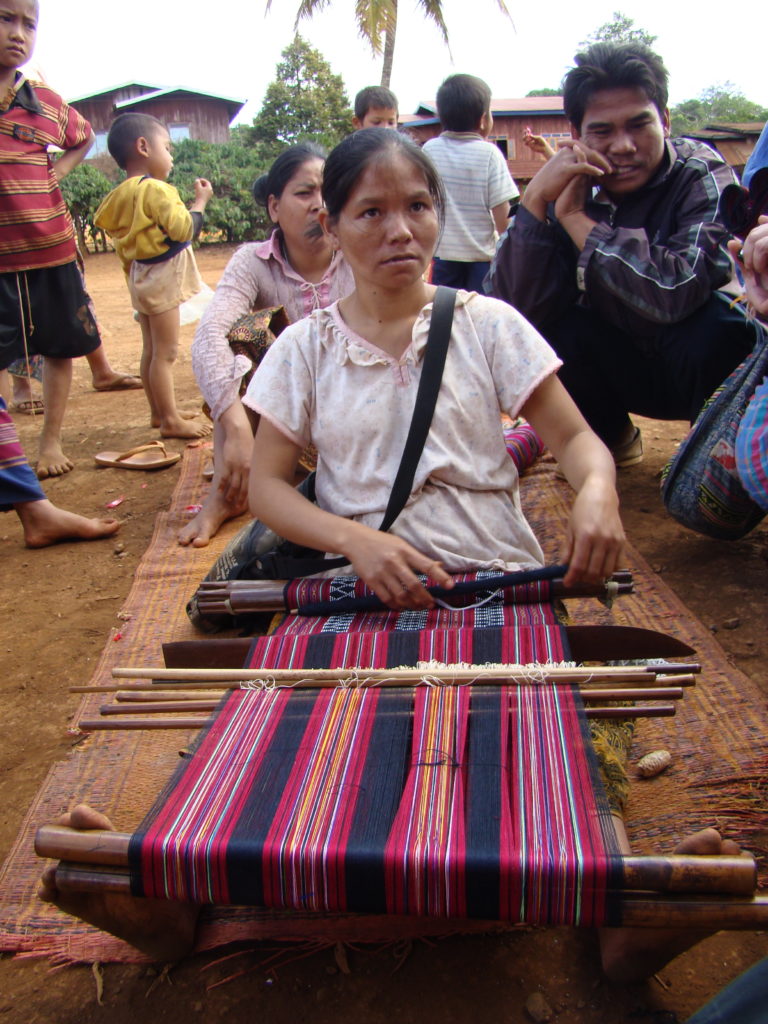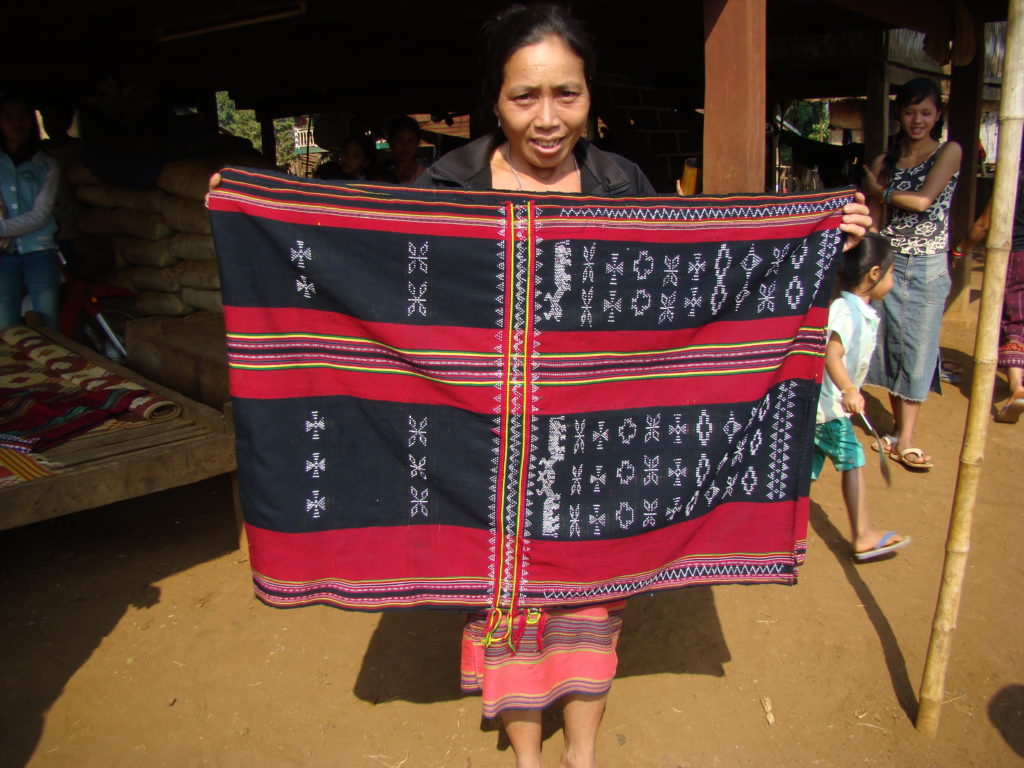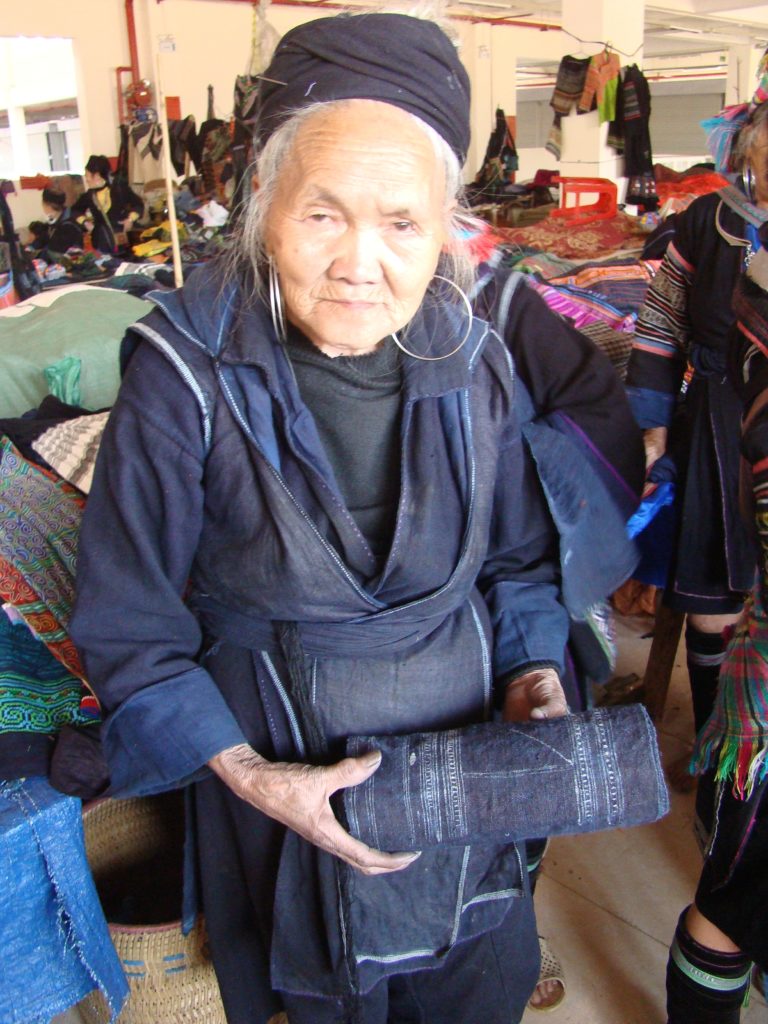This post was previously published at www.thrumsbooks.com, the website of the publisher of our recent book: Silk Weavers of Hill Tribe Laos: Textiles, Tradition, and Well-Being, and a site we’d recommend to further explore the role of textiles in today’s traditional cultures.
In 2008, in a small village in the beautiful Annamite Mountains of northern Laos, Maren and I met a Tai Daeng silk weaver who had sewn clever, flower-like tassels crafted from silk cocoons onto the fringe of a traditional healing cloth. We commented on how much we liked the decoration; it was an attractive visual detail. Returning to the same village the following year, we were surprised to find that virtually every textile offered had this flower-tassel. “We knew you liked them,” one weaver smiled.

Lun, a master dyer and weaver from Houaphan Province, Laos, dons her silk phaa phi mon, or Shaman’s shawl. The silk is locally-raised, hand-reeled, naturally-dyed, and handwoven on a floor loom. Note the flower-like tassels! Photo by Above the Fray.
Maren and I turned and stared at each other. When we started our traditional textile business, we had made an ethical consideration not to pre-order textiles from village artisans; we wanted to minimize the impact of our own aesthetic on the designs that come from the imaginations and traditions of the textile creators. Yet here were the weavers marketing themselves directly to our customers. In our naiveté, Maren and I had believed that we could both select textiles and avoid impacting the artists’ creative expression. (No doubt we also made inaccurate assumptions about the naiveté of hill tribe businesspeople.)
The truth should be spoken boldly: Creators of textiles – at least those for whom weaving is a livelihood – weave foremost to satisfy an economic need; their investment in training, materials, and time must ultimately ”turn the wheel” of a household. Thus, every textile we buy, every color choice we make, every comment about quality or design that’s heard impacts the competent artists’ effort to meet their essential economic need. Ultimately, traditional textile creation must be pragmatic, as success for weavers depends on one’s time and effort being of predictable value.
But this practical realization also finds its limits in our shrinking world.

A Katu woman in Attapeu Province weaves a traditional cloth on her backstrap loom. White glass beads are being woven onto the textile’s weft threads. The yarns are chemical-dyed polycotton. Photo by Above the Fray.
In a Katu village in Attapeu Province, southern Laos, we encounter a unique traditional woven expression: that of precisely placing patterns of beads on the weft threads as the textile is woven on a back-strap loom. Several generations ago, the Katu made their own beads from lead, poking a thin bamboo rod through a molten droplet to create the bead’s hole. These lead-beaded textiles carried a luscious chainmail drape (and rare surviving pieces now fetch hundreds of dollars a square foot). In the early 20th century, colorful factory-made glass beads became readily available, and the art of bead-making disappeared. By the mid-20tth century, chemical dyes were readily available, and the time-consuming art of naturally-dyeing cotton yarns was soon forgotten. Recently, acrylic yarns have replaced hand-spun cotton, and the regional skill and art of growing, harvesting, and spinning cotton has virtually vanished.
Today, this Katu village still hand-weaves beaded textiles on back-strap looms – albeit for tourist sales. If plastic beads were to replace the glass, or if a mechanical device were to place the beads on the threads – would that textile still be “traditional”? At what point is the integrity of authenticity challenged?

A Katu weaver holds up a stunning man’s ceremonial shoulder cloth that she recently wove. Photo by Above the Fray.
In northern Vietnam’s Lao Cai Province, the Hmong people can now buy rolls of chemical-dyed poly-cotton skirt fabric printed with the regional Hmong people’s traditional batik patterning. The rolls look much like the hand-spliced, handwoven, indigo-dyed wax-batik’d hemp that has been central to the local economy and to regional cultural identity for generations. In the marketplace, this factory-made fabric cost a fraction of what the local hemp weavers must charge.
What does makes a textile traditional? – Its design? Its artist? The artist’s culture? The method of creation? The label, or purveyor? The textile’s “story”?

In the marketplace in Vietnam’s Lao Cai Province, a Black Hmong weaver, dressed in locally-made indigo-dyed hemp cloth, holds a 6 meter long roll of hemp that her family harvested, spliced, wove, indigo-dyed, and designed with wax-resist batik. Photo by Above the Fray.
Supporting traditional textile art, artists and cultures by definition impacts the art, artists, and cultures we seek to celebrate. That is, our support generates change. From the artist’s vantage point, this dance of inviting modernity while participating in one’s cultural heritage is a tight-rope walk with far-reaching effects that unfold over generations.
The modern world can mitigate the effects of this cultural sharing by acknowledging two things:
First, for traditional textile designs and processes to remain vital and vibrant, the marketplace must fairly support the value of the creator’s time. Ultimately, a textile that doesn’t “turn the wheel” won’t be made.
And second, the voices and stories of the world’s traditional textile artists must be heard and shared. And here I’ll recommend exploring the breadth of cultural voices in the books offered by Thrums Books.
